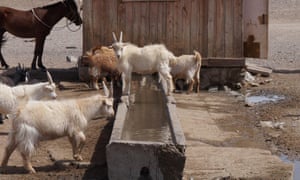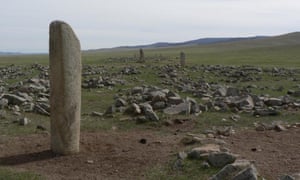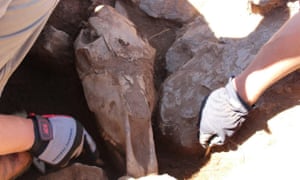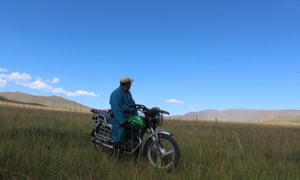Around the world, traditional subsistence practices provide a resilient source of ecological knowledge that improves humanity’s ability to respond to environmental crises. In Central Asia, a herding lifestyle practiced for millennia is increasingly threatened by the speed and magnitude of climate change.
Although the global mean temperature is predicted to rise by 2C over the coming century, this trend will likely be more severe in high altitude and high latitude environments. In the subarctic steppes of Mongolia, nearly one-third of the population makes their living through migratory herding of livestock – sheep, goat, horse, cattle, camel, and yak. For these herders, the effects of climate change have been immediate and dramatic. Mongolia has experienced summer droughts, extreme winter weather, pasture degradation, a shrinking water supply, and desertification, leading to seasonal herd die-offs. These processes have a cascading effect, reinforcing other issues caused by human activity and globalisation.
How will nomadic society respond to these obstacles? Archaeology offers a long-term perspective on the relationship between people and the environment.
In comparison to other parts of the continent, the grasslands of Mongolia are dry, cold, and inhospitable. Precipitation is infrequent and seasonal, making pastures susceptible to overgrazing. Horses, which can open snow-covered winter pastures for other livestock and move quickly over long distances, would have helped to mitigate the challenges of life in the Mongolian steppe.
Archaeologists have long been aware of the ecological advantages to horse herding and riding, and used them to develop explanations for the origins of nomadic cultures made infamous by Genghis (Mongolian: Chinggis) and Khubilai Khan. One popular archaeological theory championed by Russian scholar Anatoly Khazonov1 argues that more sedentary herders developed horseback riding and seasonal migration as a way to cope with prolonged drought during the late second millennium BCE. If mobile herding societies first coalesced during a centuries-long dry spell, contemporary climate trends might not seem such a fatal threat to nomadic life.
However, as researchers have acquired detailed record of ancient climate conditions, a different pattern has started to emerge –a link between wet, productive grasslands and the success of nomadic empires. Because water is the limiting factor for life in the Eastern Steppe, rain has a direct impact on the number of livestock an area can support. A recent investigation of paleoclimate records from the Tarim Basin of western China revealed that the great Mongol empire flourished during an anomalously wet period, linked to hemispheric cooling. “Increased carrying capacity for livestock translates into increased carrying capacity for herders,” says study co-author Dave Putnam of the University of Maine.
Putnam and colleagues argue that cooler, wetter conditions prompted the southern expansion of grasslands and made long-distance military travel on horseback through arid regions easier – favouring the spread of pastoralism, and facilitating the Mongol conquests.
Putnam cautions that their work only demonstrates a correlation, and more data is needed to demonstrate causality. However, other recent work implies that this pattern is far older than the Mongol empire.
The first direct evidence for widespread mobile pastoralism in Mongolia dates to the late bronze age, around 1200 BCE. Researcher Jean-Luc Houle at Western Kentucky University studied this early nomadic period, and found little evidence for ecological stress. Instead, he argued that these herders, who may have practiced the first horseback riding in Mongolia, seemed to have a healthy diet and an economy with enough surplus animals to conduct conspicuous ritual sacrifices – at some sites, the number of animals killed reaching into the thousands. Houle’s current studies suggest that the Xiongnu (another early empire known for prompting construction of parts of the Great Wall) also rose to power during a wetter interval at the end of the first millennium BCE.
So if the first mobile herding societies (and many nomadic empires thereafter) developed and spread under a wetter climate, what does this mean for contemporary nomads facing unprecedented warming and desertification?
The answer may be surprisingly complex. One man I spoke with, Jantsankhorloo, lives near Terelj national park not far from Mongolia’s capital Ulaanbaatar. He has seen many new challenges in his seven decades as a herder, many of them caused by human activity rather than climate. He notes that urban expansion, fencing, increased animal populations, and more traffic near the park have damaged grasslands and made subsistence more difficult. In mineral-rich areas, mining has also depleted local water sources. More than dry summers and difficult winters, he worries most about the loss of traditional knowledge among the younger generation. Many young people have left the countryside for the city, and no longer learn the skills of horsemanship and animal husbandry. In the coming years, the success or failure of Mongolian nomadic life may depend in large part on how people respond to and mitigate these anthropogenic problems.
Modern technology has also impacted herding. Many herders living in the drier, flatter Gobi regions have abandoned horses for Chinese motorbikes – enabling them to move farther distances with their animals, and cope with easily overgrazed pastures. Critics denounce the practice as “lazy” and un-Mongolian, expressing concerns about the effect it may have on the environment and livestock health. Even as technology helps herders cope with changing ecological parameters, it may also have unintended consequences.
With this whirlwind of social and technological change occurring alongside the changing climate, it’s unclear exactly how the future may play out for nomads in eastern Eurasia. Nonetheless, it seems unlikely that wet and productive environment that accompanied the emergence of horse culture in the region – and some of its greatest nomadic empires – will characterise the near future. As arid conditions stretch further northward, Putnam sees many herders “caught between a desert and a cold place” – with less biomass translating into reduced forage, and a narrowing window for nomadic life. As climate change endangers Mongolia’s herding traditions, it also threatens ecological knowledge essential to our collective resilience to environmental disaster.
Further reading:
Houle, Jean-Luc. 2010. Emergent complexity on the Mongolian Steppe: mobility, territoriality, and the development of early nomadic polities. PhD dissertation, University of Pittsburgh.
Khazanov, Anatoly. 1984. Nomads and the Outside World. Madison, University of Wisconsin Press, pp. 89-97
Putnam, A et al. 2016. Little Ice Age wetting of interior Asian deserts and the rise of the Mongol Empire. Quaternary Science Reviews 131: 33-50.





1 comment:
Ancient climate changes affected the Eurasian steppes >> Modern warning:
http://www.ibtimes.co.uk/genghis-khans-expansionist-empire-aided-by-ideal-climate-study-1439841 (retrieved Nov 11 2015):
'Genghis Khan's Expansionist Empire Aided by Ideal Climate – Study'. - By Divya Avasthy. March 11, 2014
http://www.livescience.com/44025-warm-climate-mongol-invasion.html (retrieved Jun 7 2015):
'Warm, Wet Climate Likely Helped Genghis Khan Conquer the World'. By Stephanie Pappas, Senior Writer | March 11, 2014 02:39pm
http://archaeologynewsnetwork.blogspot.dk/2015/02/climate-change-of-northern-china-re-gion.html?utm_source=feedburner&utm_medium=email&utm_campaign=Feed:+TheArchaeologyNewsNetwork+(The+Archaeology+News+Network)#.VOmejPmG9FM (retrieved Feb 22 2015):
'Climate change of northern China region dates back thousands of years'. - Posted by TANN. Author: Tonya B. Lewis | Source: Baylor University [February 17, 2015].
http://archaeologynewsnetwork.blogspot.dk/2015/01/rapid-desertification-may-have.html?utm_source=feedburner&utm_medium=email&utm_campaign=Feed:+TheArchaeologyNewsNetwork+(The+Archaeology+News+Network)#.VLgq7yuG- (retrieved Jan 15 2015):
'Rapid desertification may have destroyed China's first kingdom'. - Posted by TANN. Author: Charles Q. Choi | Source: LiveScience [January 09, 2015].
http://www.pnas.org/content/112/3/702 (retrieved Feb 22 2015):
'Groundwater sapping as the cause of irreversible desertification of Hunshandake Sandy Lands, Inner Mongolia, northern China', by Xiaoping Yanga, Louis A. Scuderib, Xulong Wangc, Louis J. Scuderid, Deguo Zhanga, Hongwei Lia, Steven Formane, Qinghai Xuf, Ruichang Wangg, Weiwen Huangh, and Shixia Yangh.
Post a Comment